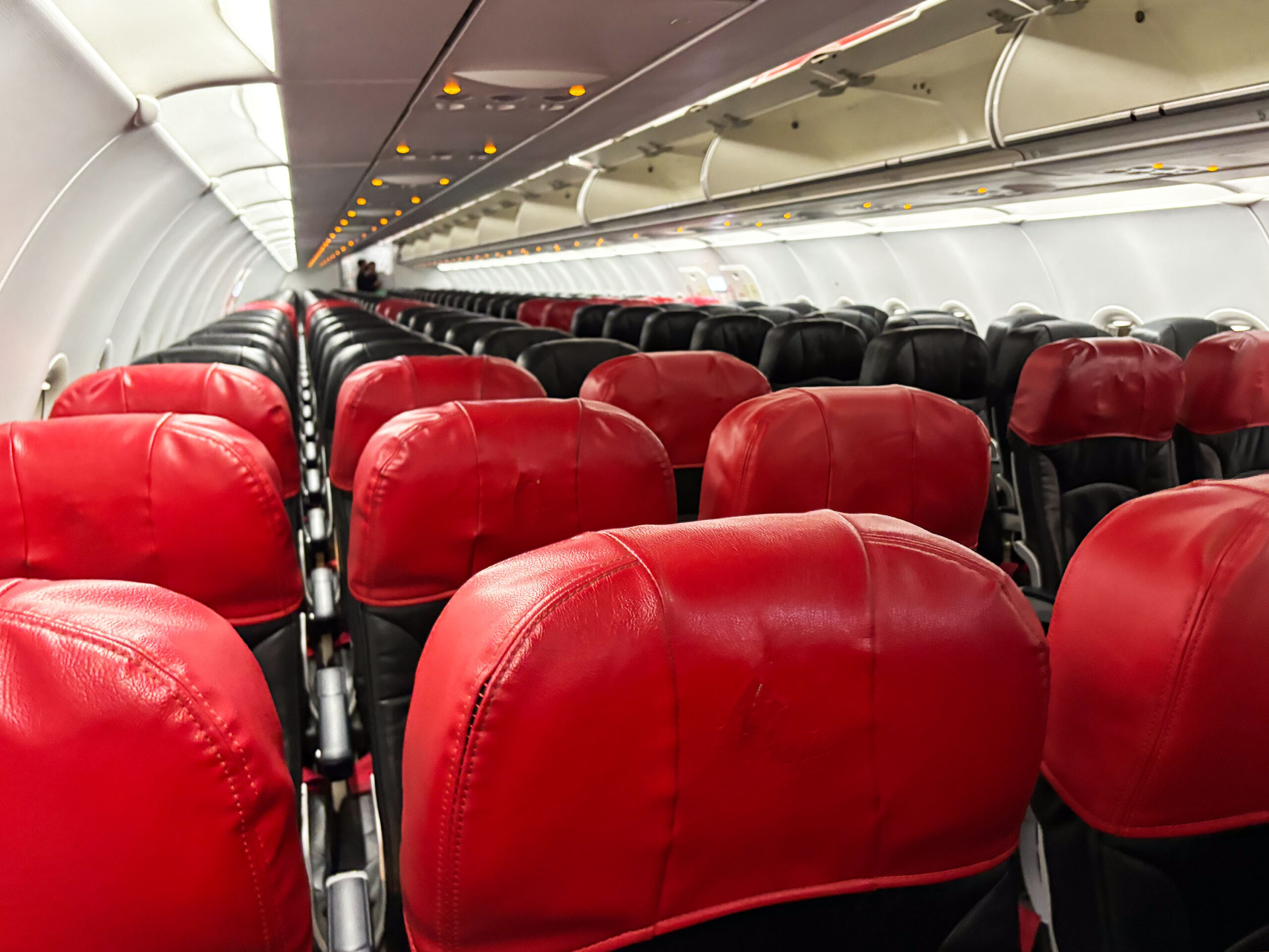
AirAsia flight details
Airline : AirAsia (Malaysia)
Flight No : AK380
Departure City : Kuala Lumpur (KUL)
Arrival City : Jakarta – Soekarno-Hatta (CGK)
Equipment : Airbus A320neo (9M-AGI)
Blocked Time : 2h10m
Seat No: 2F
While I’ve flown and reviewed Indonesia AirAsia’s A320 Hot Seat product in the past, I’ve yet to try the original AirAsia Malaysia (AK). Founded in 1993, the airline originally started up as a full-service carrier owned by a government conglomerate. The failing airline was bought by Malaysian entrepreneurs Tony Fernandes and Kamarudin Meranun and was envisioned to provide affordable air travel to everyone. Over 20 years later, it has done just so, carrying over 800 million passengers to destinations around the world.
Booking AirAsia
While I love AirAsia’s concept and vision, I’ve always found their website to be very frustrating to navigate. Ever since AirAsia was overhauled into a ‘super app’, it has become so complicated to merely look only for AirAsia flights. Furthermore, you will need to make an AirAsia Big Loyalty account before you can even book any flights. The airline is perhaps also a low-cost carrier in its purest form. Ancillary services (like meals, baggage, and seats) are cheapest when you initially book and would increase in price as you get nearer to the departure date. Yikes.
As I was travelling over the New Year period, virtually all airfares were absurd. After weighting between flying AirAsia or Malaysia Airlines for three times the price, I settled for the former. In the end, I paid MYR 457 (~ USD 102, GBP 76), which I think is very steep for an early morning flight on a low-cost carrier. On top of that, I paid MYR 68 for a 20kg checked baggage allowance, MYR 15 for an inflight meal, and MYR 34 for a second row Hot Seat. In total, this came up to MYR 572 (~ USD 122, GBP 96).
Check-in
Terminal 2
After an early morning check out from the Grand Millennium Kuala Lumpur, I fittingly took an AirAsia Ride (the airline’s ride-hailing venture) to Kuala Lumpur International Airport Terminal 2 (formerly KLIA2). As I arrived at the terminal’s kerb, my weary eyes were stung by the bright numerous AirAsia digital ads plastered all over. ‘Home of the World’s Best Low-Cost Airline’, they read.

Check-in Experience
After walking past a food court-like area and crossing over another drop-off lane, I found myself at the busy check-in hall. While Terminal 2 is still relatively new, I was surprised to see how poorly it has aged. For one, the dingy lighting and the hecticness of the check-in hall reminded me of a bus terminal in New York.

At the very least, it wasn’t difficult to find the AirAsia check-in desks. This isn’t surprising given how AirAsia operates the majority of departing flights from the terminal. In fact, only three other airlines operate from Terminal 2 – Jetstar Asia, Scoot, and Cebu Pacific. Notably, the check-in hall is littered with AirAsia self check-in kiosks, which you’ll have to use if you haven’t checked in online. While counter check-in is available, they incur a fee à la Ryanair.

It is only after you print your boarding passes and bag tags that you are allowed to line up to check your bags. The queue was staffed by two AirAsia ground agents, who weren’t particularly friendly or helpful. Although the line wasn’t very long, it moved very slowly, perhaps because many people aren’t well-versed in dropping their own bags. At the very least, if you paid to check in more than one bag, the weight is calculated cumulatively rather than per piece.

After dropping my bags, I headed to the security and immigration checkpoint, the entrance of which was also manned by AirAsia ground agents. They randomly checked boarding passes and eyed for cabin bags which may be overweight. Unexpectedly for this early morning departure, there were a lot of angry passengers arguing with the agents about their overweight cabin bags. How hectic!

Boarding
Being my first time departing from Terminal 2, I was surprised to see how stuffy and poorly designed the terminal was. Contrasting the modern and sleek exterior, the airside hall was drab and dimly lit, with low ceilings. Much of the terminal’s non-gate area does not even have windows!

The experience was only exasperated by the ground staff and security, who were curt at best and rude at worst. I wasn’t sure if it was due to the early morning timing but it sure felt like everybody had had their nerves struck. Coincidentally or not, AirAsia’s proud ‘World’s Best Low-Cost Carrier’ posters and advertisements have dissipated as we reached this dreary part of the terminal. Well, at least there are a handful of colourful lines to lift the mood, right? 😉

I reached the boarding gate about five minutes before our printed boarding time of 06.15, 40 minutes before departure. I was met with a short queue at the entrance, where we had our boarding passes scanned and documents checked. The checks ultimately led to a tiny holding pen, which I felt ended up being too small to even fit an Airbus A320-load of passengers.

I soon noticed that our boarding time had been pushed back by three minutes. As this was the first place where I could finally take a close look out the windows, I took the time to check out our jet. Taking us to Jakarta today is 9M-AGI, an Airbus A320neo delivered new to AirAsia in December 2017.

Preboarding later started at 06.20, followed by priority boarding for Hot Seats passengers two minutes later. As I had already been close to the gate entrance, I became the first to board the aircraft!

AirAsia A320neo Cabin
AirAsia Airbus A320neos are equipped in a standard high-density, all-economy configuration with 186 seats. Despite being newer, the A320neos retain largely the same configuration as other AirAsia group A320s; the seats are identical to those on the Indonesia AirAsia flight I flew earlier in the year.


The first five rows of those are categorised as Hot Seats, alongside the two emergency exit rows. These seats are distinguished by their hot red seat head covers. Despite its special moniker, the seats come with few benefits except for its location in the pointy end. Apart from row 1 and the emergency exit rows, most Hot Seats notably share the same seat pitch as regular seats.


As row 1 was already fully reserved, I booked seat 2F, allowing me to get a sense of the legroom. At 180 cm (5’11), there was around 4 cm between my knees and the seatback when sitting completely upright. Unsurprisingly, the seat pitch was advertised as ‘up to 29 inches’ (73.5 cm), whereas the space between the seat and the seatback pocket was 24 cm (9.5 inches).


Save for the legroom, the seat itself is quite comfortable and features good padding. It was certainly more comfortable than the ironing board-like ultra-slimline seats you get on TransNusa or Lufthansa, for example. As always, the seat comes with a sturdy tray table and a netted seat pocket. The aircraft is also equipped with overhead air vents, which are always appreciated.


Departure from Kuala Lumpur
As boarding went underway, I noticed Malaysian pop music playing in the background. Contrasting the Western pop they play on Indonesia AirAsia, this added an interesting local flair to the experience. What was more interesting, however, were the inflight announcements. More than once, we were greeted by Inflight Manager Farah, who proudly exclaimed ‘Welcome aboard AirAsia, the world’s best low-cost carrier’. Setting up expectations high today, aren’t we?

Following that were a couple of announcements, stating that ‘rows 1-5 were reserved only for Hot Seats and seat switching is not allowed’. Not that seat switching was possible anyway, since our flight ended up completely full with 186 passengers. We pushed back shortly after the boarding door was closed at 06.54, one minute before our scheduled departure time.


As we pushed back and taxied, Captain Richmond and First Officer Darryl greeted us on the intercom, detailing our flight time of 2 hours and 10 minutes. Despite their best efforts, the announcement was muddled, which is surprising for such a new aircraft. At the very least, the safety announcement that followed was slightly clearer.


After taxiing past a bunch of other AirAsia A320s, we reached Runway 33, parallel to Terminal 2. We took off at 07.07 just as the sun continued to rise, treating us to some glorious views of Sepang and Selangor as we gained altitude.




Inflight Service
The seatbelt signs were extinguished seven minutes after takeoff, prompting the cabin crew to jump and start the inflight service. An automated inflight announcement regarding the sale of refreshments and duty-free goods was made soon after, followed by a radio-style advertisement for a bank.

For reference, you’ll find AirAsia’s Santan inflight menu below, which is updated quarterly. You can also browse the latest menu on AirAsia’s website. If you know you’re going to eat on the flight, I’d advise you to prebook online to guarantee your choice (as I did). You’ll also save a few Malaysian Ringgits in doing so too.

Having tried AirAsia’s signature Pak Nasser’s Nasi Lemak earlier in the year, I decided to mix things up and pre-booked the Bukhara Chicken Biryani. While I initially thought about getting Uncle Chin’s Chicken Rice, I quickly changed my mind. I mean who doesn’t love Indian food on a plane?

My inflight meal was promptly served piping hot before the crew started rolling the trolley down the aisle. This came with a side of bottled water and plastic cutlery. With the lid uncovered, the Bukhara Chicken Biryani meal consisted of a few pieces of chicken curry and achar pickles over a bed of spiced basmati rice.

While the meal was representative of the advertised picture, I was surprised by how bland it tasted compared to the absurdly spicy Pak Nasser’s Nasi Lemak. For one, the meal’s flavour lacked depth and didn’t taste particularly fresh. Oh well. At the very least, I’ll have to commend the crew, who were friendly and remained cheerful despite our ghastly early morning departure. If AirAsia is the best low-cost carrier for something, it’s probably for their crew!
Lavatory
Soon after finishing my meal, I found myself needing the lavatory, requiring me to gingerly and awkwardly hop over my seatmates. I guess that’s what happens when departure gates do not have toilets! Anyway, what I found was a run-of-the-mill Airbus A320 lavatory. It was neither dirty nor very clean, so I felt indifferent one way or another.

Arrival in Jakarta
Just as my two seatmates had been doing, I tried to catch up on sleep for the remainder of the flight. Sadly, the choppy rainy weather didn’t make this attempt very long-lasting. As I stared blankly out the window, Captain Richmond came to the intercom, abruptly ending my thoughts of regret for not downloading any Netflix shows before this flight. He announced that we were expected to arrive early at 07.55.

With just under 30 minutes to go, the cabin was prepared for arrival, at which time the crew went down the aisle to collect any remaining trash. The seatbelt signs were lit soon after. Following that were automated advertisements that were played over the intercom. Come to think of it, this is perhaps the first time I’ve heard anything of the like on any airline!


As we descended, it was clear the weather wasn’t getting any better. While the rain had subsided, Jakarta was still under significant cloud cover, preventing me from seeing much in terms of view. Anyway, we soon approached Jakarta before touching down smoothly on Runway 25R.


We ultimately arrived at 07.47, 18 minutes earlier than our scheduled arrival time of 08.05. Before long, we taxied past a handful of Lion Air Boeing 737s to our snug parking position at Terminal 2F – the airport’s dedicated low-cost carrier terminal.



Verdict
While the service was good and the seats were identical to Indonesia AirAsia, this was an experience I wasn’t looking to repeat. So why is my rating so low? Well, the entire experience from checking in to getting on board was just unnecessarily stressful. Between the dynamic add-on pricing, the grim-looking terminal, the curt ground staff, and the mediocre food, very little is ‘world-class’.
So much for the world’s best low-cost airline. I mean seriously, I’ve flown my fare share (pardon the pun) of low-cost carriers and this AirAsia experience was near the bottom of the barrel. For one, if I could name a low-cost airline as the best in the world, it would probably be Norwegian Air Shuttle (Free WiFi? Yes please!). I’d even rate airlines like Jetstar, Spring Airlines, and even perhaps Scoot higher than this! Perhaps I wouldn’t have been so disappointed if the airline didn’t plaster this title all over my face.
But having said that, we’ve finally wrapped up An Emerald Farewell. Thank you so much for reading and do stay tuned for Jakarta Potato’s next adventure: An Indian Subcontinent Extraordinaire!


Leave a Reply